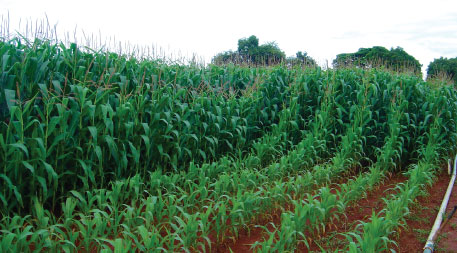June 4, 2013 — In Aldous Huxley’s dystopian Brave New World, citizens contribute to society even after death. As gases exit a crematorium smokestack, a special device recovers phosphorus — “more than a kilo and a half per adult corpse.” The recovered phosphorus then fertilizes all manner of plant life, which thrives on this vital nutrient recycled from the remains of the dead.
Huxley’s account is remarkable because it was written in the early 1930s, when far less public attention was devoted to the supply of natural resources. In fact, the full potential of phosphorus would be demonstrated several decades later. Its targeted use fueled the green revolution of the 1960s and 1970s, which dramatically improved crop yields and helped minimize the proportion of the world’s population remaining underfed.

Adding phosphorus to nutrient-poor soils can dramatically enhance crop production. Maize plants in the foreground of this photo taken on Brazil’s cerrado are growing on unsupplemented soil; the taller ones behind them received phosphorus fertilizer. Photo by D.M.G. De Sousa.
Farmers around the world have come to depend on manufactured inorganic fertilizers containing key plant nutrients phosphorus, nitrogen and potassium to enhance soil fertility, especially in the otherwise poor soils of most tropical settings. But while all three are relatively abundant in nature, commercially viable sources of phosphorus to make these fertilizers could be exhausted just a few decades from now. That prospect, which remains a source of heated debate, has spurred a drive to recover the significant quantities of this element that disappear in the waste streams of cities and farms. Such recovery would have a bonus benefit: Even without the threat of shortages, minimizing the disposal of phosphorus is increasingly key to preventing degradation of valuable freshwater resources.
Momentous Shift
The availability of nitrogen, phosphorus and potassium in soil is a limiting factor in plant growth. The limitation imposed by phosphorus is the strictest, based on the amount of this material that plants take up and concentrate. Since all living organisms incorporate phosphorus in varying chemical combinations, modest amounts are relatively easy to obtain from biological sources. Spreading animal manure on fields is among the oldest known ways to add phosphorus to a crop. Urine can also be effective. Guano from birds and bats is exceptionally rich in this regard, as is bone meal.
“Increasing environmental, economic, geopolitical and social concerns about the short- and long-term use of phosphate rock in agriculture means there is a need to reassess the way crops obtain their phosphorus and humanity is fed.” — Dana CordellYet even as Huxley was writing, and certainly by the time the green revolution rolled around, such organic inputs were no longer sufficient to match the scale of agricultural output. As a result, most of the phosphorus that ends up on fields today comes not from organic materials, but from inorganic phosphates extracted from geological deposits.
This distinction makes no difference to crops. For our society and economy, on the other hand, the shift has been nothing less than momentous.
“Today, we are effectively dependent on phosphorus from mined phosphate rock,” says environmental scientist Dana Cordell, a research principal at the Institute for Sustainable Futures in Sydney, Australia. In many places, such as Brazil or central Africa, phosphate-based fertilizers are essential to maintaining crop yields and ensuring domestic food security. And that, Cordell says, spells trouble. For her, inorganic phosphates represent a nonrenewable resource that contrasts sharply with traditional sources of phosphorus such as manure, which are integrated into a natural environmental cycle. And because they’re only found in certain areas, global politics comes into play.
“Increasing environmental, economic, geopolitical and social concerns about the short- and long-term use of phosphate rock in agriculture means there is a need to reassess the way crops obtain their phosphorus and humanity is fed,” she says.
Peak Phosphorus?
Some, including Cordell, see a limited future for the conventional mining of phosphates. Easily obtained, high-quality deposits of this material will become harder to find, and its price could be expected to rise accordingly. Production should ultimately peak as commercially viable supplies become more limited, reducing the amount of phosphorus available for use as fertilizer. This reduction would be reflected by declining agricultural production in some parts of the world, along with the specter of mounting hunger.
What remains a point of contention is exactly when such problems might arise. Cordell and others insist that this scenario could play out in a very few decades, as the quality of available phosphate begins to decline.
“Importantly, this means increasing energy and other resources (like sulfur) are therefore required to mine, process and extract the same nutrient value from phosphate rock while simultaneously generating more waste,” she says. “Further, the global trade of phosphate commodities to the farm gate currently relies on fossil fuel energy, yet in a carbon-constrained future, shipping millions of tons of phosphate rock and fertilizers around the globe may no longer be appropriate or possible.”
Opponents of this view harken back to doomsday forecasts framed decades ago by prominent analyses like The Limits to Growth or The Population Bomb. Economic and environmental disasters that should already have overwhelmed us by now have instead been postponed indefinitely, thanks to changes in our behavior, economic policy or technological capabilities. Discussion of those disasters undoubtedly prompted at least some of the necessary changes, and could do so again in the case of phosphorus.
This optimistic perspective benefited from a 2010 revision of estimates of the world’s phosphate reserves. New figures from the International Fertilizer Development Center raise the estimate from 16 billion metric tons to more than 60 billion metric tons. The author of that report, geologist Steven Van Kauwenbergh, insists that this finding should put an end to any immediate concerns about peak phosphorus.
“Based on this estimate,” he says, “at current rates of production, phosphate rock reserves to produce fertilizer will be available for 300 to 400 years.”
At the same time, Van Kauwenbergh cautions that the sources of information used for this estimate tend to be limited, provided primarily by industrial interests. “A collaborative effort by phosphate rock producers, government agencies, international organizations and academia will be required to make a more definitive estimate of world phosphate rock reserves and resources,” he concludes.
Brave New Sources
Even if phosphate is more abundant than previously thought, the distribution of reserves poses a big challenge.
According to the U.S. Geological Survey’s latest figures, published in January 2013, Morocco and Western Sahara appear to contain no fewer than 50 billion of the estimated 67 billion metric tons of phosphates, some 74 percent of the total. The rest is found in various places in much smaller amounts, with 5.5 percent in China, 3.3 percent in Algeria and 2.7 per cent in Syria. The remainder is spread among the rest of the world’s nations, with major agricultural countries such as South Africa, Russia, and the United States each holding less than 2.5 percent.
One promising technology is a chemical reactor that can be installed in municipal wastewater streams, where human urine provides a rich supply of raw material.In addition to political considerations, poor transportation links limit the volume of fertilizer reaching farmers in some countries, where a correspondingly high price makes this input all the less accessible. Even without the dire threat of peak phosphorus, as growing population boosts demand for food, intensifying competition along narrow international supply lines could place fertilizers beyond the reach of many more farmers.
Faced with this challenge, sources like that tapped in Brave New World could take on a fresh appeal. In fact, though it does not yet extend to crematoria, phosphorus recovery is not consigned to science fiction.
One promising technology is a chemical reactor that can be installed in municipal wastewater streams, where human urine provides a rich supply of raw material. Urine forms the basis of ammonium magnesium phosphate, a white crystal known as struvite. Struvite cakes on the walls of sluiceways and sewers, hardening into a concrete-like consistency that is onerous to remove.
Struvite, if it can be extracted in a pure form, offers the basis for an effective fertilizer. For example, an extraction technology produced by Vancouver-based Ostara Nutrient Recovery Technologies Inc. has been installed in cities in Canada, the U.S. and the U.K. The system, like others, aspires to provide a cost-effective means of capturing struvite for agricultural use.
The Other Half
The other half of the phosphorus predicament, ironically, is a problem of localized overabundance. Soils in many parts of North America have naturally high levels of phosphorus. Add too much more in an attempt to boost crop yields, and nutrients drain off the land to fertilize lakes and rivers. What often follows is the proliferation of algae in these waters, which then become oxygen-poor and inhospitable to plant or animal life. This process, known as eutrophication, can compromise aquatic ecosystems.

For much of human history, cow manure served as a valuable source of phosphorus for fertilizing crops. Today the concentration of cattle in feedlots creates a localized over-abundance of the nutrient, transforming it from treasure to trouble. ©iStockphoto.com/mauroscarone.
“We have understood the causes of eutrophication for more than 40 years, while the drivers have gotten worse,” says Stephen Carpenter, a professor at the University of Wisconsin’s Center for Limnology in Madison. “Increased planting of corn, increased livestock numbers and increasingly variable precipitation due to climate change are principal drivers of increased eutrophication. We decreased the discharge from sewage treatment plants, but at the same time the runoff of manure and overfertilized soil became much worse.”
Carpenter has been studying eutrophication since the mid-1970s, when the high-profile damage to Lake Erie shamed detergent manufacturers into lowering the phosphate content of their products. By the late 1990s, he observes, researchers were finding most of the ongoing eutrophication in North America was due to phosphorus runoff from farms. Most recently he considered what the ultimate planetary boundary might be for phosphorus discharge into the environment, a matter he explores as co-author of a 2011 paper in Environmental Research Letters.

Phosphorus leached from soil, vegetation and manure stimulates the growth of algae in surface waters. Nutrient inputs from its mainly agricultural catchment basin have earned Lake Winnipeg the title of the world’s largest eutrophic lake. Photo by Greg McCullough.
That paper argues that the boundary for the discharge of phosphorus into freshwater has already been exceeded. At the same time, many parts of the world remain in urgent need of phosphorus in order to be able to feed themselves. Carpenter suggests that regions with a surplus of phosphorus could solve two problems at once by packaging that surplus in the form of struvite for markets elsewhere.
“Midwesterners are rich in phosphorus, but they also suffer lots of toxic algae blooms and fish kills,” he says. “Technologies to convert manure to lightweight [high-phosphorus] materials would help cure eutrophication in the Midwest while curing hunger in Africa.”
Bennett maintains that the cost of reducing phosphorus discharge should be weighed against the value of services provided by the environment under threat. As straightforward as that objective might appear to be, it conflicts with the ruthless economics of modern agriculture. According to Carpenter’s co-author, Elena Bennett, large-scale livestock operations can leave little financial room for investing in technology to recover phosphorus, as the expenses associated with recovery equipment will not necessarily be recouped by sales of the resulting product.
“We’ve moved from a system a couple of hundred years ago where you had a couple of cows and a couple of chickens and some corn, and so the manure was a useful resource,” explains Bennett, an assistant professor at McGill University’s Department of Natural Resource Sciences. “Now, things are just out of whack at the scale that we operate.”
That doesn’t mean that phosphorus removal is uneconomical, however. Bennett maintains that the cost of reducing phosphorus discharge should be weighed against the value of services provided by the environment under threat. Depending on the site in question, those services could include clean drinking water, recreational opportunities or hydroelectric power generation.
“This isn’t about the natural world versus the developed world,” insists Bennett. “This is about nature providing us with all these things, and some of those things it provides better when it’s in a natural state and other things are better in a built state. If we can understand which states provide which amounts of which services, then we can start making more informed decisions.”
Wetlands to the Rescue
This principle is being put forward to deal with the specific challenge posed by Lake Winnipeg, which has been touted as the world’s largest eutrophic lake. That dubious honor stems from the lake’s role as a catchment basin for four Canadian provinces and four U.S. states, concentrating soil runoff in this primarily agricultural region. According to the International Institute for Sustainable Development, based in the city of Winnipeg, much of that runoff travels unimpeded into the lake because coastal wetlands have been drained for farming.
IISD project manager Vivek Voora says that convincing farmers to leave wetlands in place to capture phosphorus and other nutrients from runoff rather than allow them to fertilize the lake amounts to competing with the value of those wetlands as planted fields. Delta Waterfowl, a longstanding Manitoba organization dedicated to preserving marshes for hunting, tries to match that value dollar for dollar with financial compensation to farmers who set aside wetlands. But as the price of some crops rises, this amount may not remain competitive with other uses for the land.
“We need to find a way to show farmers that managing a wetland is profitable,” Voora explains.
Voora has explored how natural wetlands could take part in a novel biological economy. Plants such as cattails could be harvested for conversion into bioplastics, or pelletized to become fuel. Meanwhile, the intact wetland will sop up most of the nutrients that would otherwise reach the lake.
In this sense, Voora points out, wetlands function as important pieces of ecological infrastructure. They may not be as focused and efficient as the kind of infrastructure cities could use to retrieve phosphorus from their wastewater for use elsewhere, but they can provide crucial services on farms where such built infrastructure is unlikely to appear.
“A nutrient that is so fundamental to the economy of this particular region,” Voora says, “for us to be wasting it, for it to end up in water bodies and causing environmental problems, doesn’t make a bit of sense.” ![]()
A version of this feature originally appeared in the Fall 2011 issue of Momentum magazine, Ensia’s predecessor.
Ensia shares solutions-focused stories free of charge through our online magazine and partner media. That means audiences around the world have ready access to stories that can — and do — help them shape a better future. If you value our work, please show your support today.
Yes, I'll support Ensia!

Small scale and organic is already feeding the large majority of the world, probably in the neighborhood of 70% or so. Yet we spend so much time worrying about industrial totalitarian agriculture. Why should this be? Because it is the industrialized countries that mostly eat the food that comes from this system. It's not really the developing world that needs totalitarian agriculture, it's us, the privileged. It's us who would starve because we have become so divorced from where our food comes from and how to go about growing it.
Plus, organic farms per se are not always closed loop nutrient systems. They often depend on manure inputs, usually from conventional farms (often with chemical fertilizers used in the animal feed) down the road. It's rare to find any truly closed nutrient loops in agriculture anywhere, conventional or organic. So, organic is not automatically a solution to all of this, although it is clearly better in many respects.
With that said, major changes in nutrient use is needed, and you identify a great many of the challenges we need to address. It's a big problem.
I agree that Certified Organic agriculture is almost identical to industrial chemical agriculture. It is still a tilled monocultural disaster. It just doesn't have the poisons as an input, and so is marginally better for us and ecosystems. But still disastrous.
As for the 70% figure... I am talking about global food provisioning. Not your food, not my food. Global. We live in the "First World." (I assume you live in a "First World" nation...)
Here is a summary of a report that estimates, because the hard data is not available, that conservatively "70% of the food the world actually consumes every year is provisioned by rural and urban
peasants." Peasants can't afford chemicals or seed, and so have to find other ways to ensure fertility. They may not be Certified Organic, but they are cycling nutrients somehow. http://www.etcgroup.org/sites/www.etcgroup.org/files/Who%20will%20feed%20us%20all.pdf
Here is another little tidbit out of Russia that says that small family held farms are producing a sizable quantity of food in that industrialized country. http://thebovine.wordpress.com/2009/08/09/in-1999-35-million-small-family-plots-produced-90-of-russias-potatoes-77-of-vegetables-87-of-fruits-59-of-meat-49-of-milk-way-to-go-people/
Other estimates say that about 15% of food production is in urban areas, 85% of food is "local," and 75% of farmers save seed and grow locally adapted varieties. If you are saving seed, you're probably not dousing it with chemicals.
Like I said before, if the industrial agriculture system were to fail tomorrow, it would be you and I that would probably starve. We are heavily invested in the linear paradigm of food production. Our lives depend on it. The non-industrialized parts of the world would get along pretty well. I humbly propose that we have a lot to learn and the poorest among us should be our teachers. But if we live under the illusion that industrial agriculture is currently feeding most of the people, then we won't be able to visualize what is possible from a different paradigm.
Shouldn't Ensia, a blog about sustainability, have articles that are framed within a sustainability paradigm?
So, help is on the way! (?)